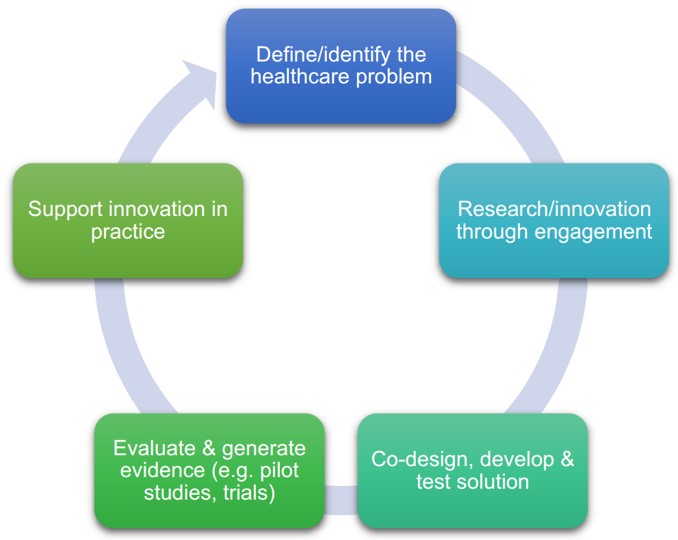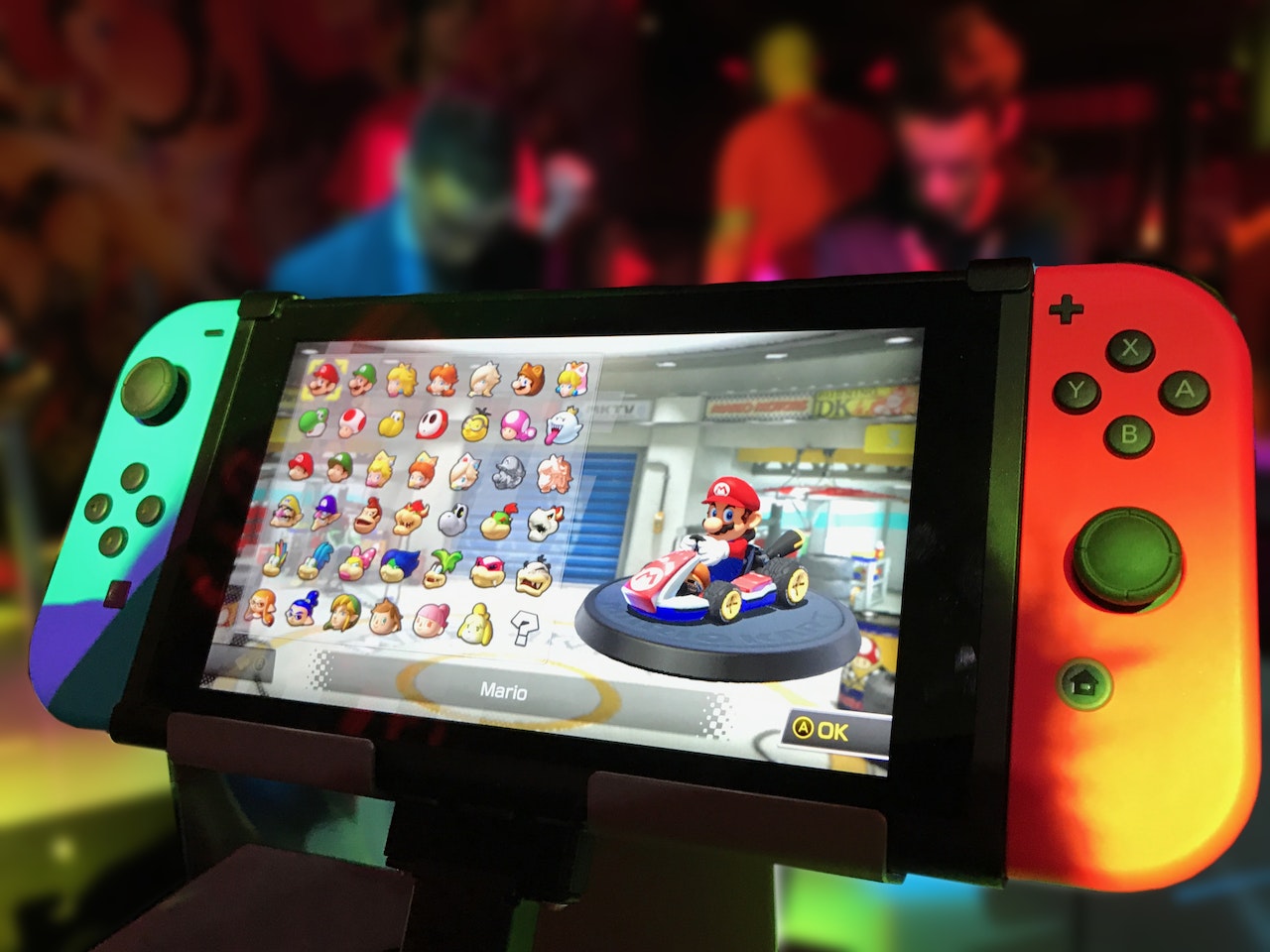Throughout my career as a digital health practitioner, I have always advocated that for any digital healthcare technology or digital health innovation, the digital healthcare innovation cycle should always be followed. One should not be focusing on the technology and then finding a healthcare problem to “fit” the technology, but rather, one should be focusing on the healthcare problem and finding the technological solution to addressing the problem. This approach will enable sustainability of the technology and the innovation in clinical/healthcare practices.
The concept of the digital healthcare innovation cycle is fairly simple, and is somewhat similar to most design thinking processes for healthcare innovations. As described in Wikipedia, it is an iterative process that consists of 5 main activities from defining/identifying the healthcare problem, researching/innovating through engagement with stakeholders, co-designing, co-developing and testing the digital health innovation through collaboration among clinical/healthcare professionals and technological experts, evaluating and generating the evidence through clinical studies, and implementing and supporting the digital health innovation in clinical practices.

Needless to say, this cycle should also be applied to the field of serious games if it is used for the purposes of healthcare and healthcare education. Serious games, game-based learning and gamification have become popular in recent years for healthcare education and training, especially with the advancements in virtual reality, augmented reality and mixed reality technologies, and more recently, the metaverse. In my own experience, I had also followed the digital healthcare innovation cycle to develop a serious game for pharmacy education, by finding out about our target audience (i.e. pharmacy students), as well as conducting several rounds of evaluations for the in-house game that we developed.
Having being in this field for quite a while now, I have realized that many healthcare professionals and healthcare educators want to use serious games and/or game-based learning for their work in clinical practice and education/training. However, when I discuss more in depth as to what they want, I realize that they really just want a simulation or some gamification in their work. And many of them are fixated on wanting to use virtual reality or mixed reality to develop their so-called games. It’s a wonder that many times, as healthcare practitioners, we tend to forget our own emphasis that technology is not the “end-all” but just “a means to an end”. I started to wonder if there really was a need to distinguish among the terms of “serious games“, “game-based learning” and “gamification“, since most people use these terms interchangeably, including game vendors! However, I realized that without knowing the differences among these terms, it was not only confusing to the healthcare professional/educator who wanted to develop the game, but it also led to the lack of clarity in communication and at times, misunderstandings with the vendor – talk about the communication between “chicken” and “duck”…
I decided to do a search on whether there is any formal distinction among these terms. From a quick literature scan, I found the following articles the most useful for purposes of distinguishing among all the commonly-used terms in the field of serious gaming, which I have combined in the table below:
- Becker K. What’s the difference between gamification, serious games, educational games, and game-based learning? Acad Letters 2021; article 209.
- Laning T. Serious games, gamification and game-based learning: What’s the difference? Grendel Games. 30 Aug 2020.
| Parameter | Game | Serious Game | Game for Learning (G4L) | Game-based Learning (GBL) | Game-based Pedagogy/ Teaching (GBP) | Gamification |
|---|---|---|---|---|---|---|
| Definition | Includes both Serious Games & Games for Learning | A custom-built game designed for purposes other than (or in addition to) pure entertainment | A game designed specifically with some learning goals in mind | Process & practice of learning by using games [From learner’s point-of-view] | Process & practice of teaching using games [From educator’s point-of-view] | Use of gaming elements in a non-gaming context |
| Purpose | Can be for any purpose | Create awareness; Change attitude, behavior, health; Transfer knowledge & understanding; Train new skills | Usually connected with some educational goals | An approach to learning to transfer knowledge & understanding and/or train new skills [Not a game] | An approach to teaching to transfer knowledge & understanding and/or train new skills [Not a game] | Often used to increase motivation and engagement, or enhance the user’s experience, but also can be used to make the activity more game-like & playful |
| Primary Driver (why used) | Can be either play or rewards or both | To get the message of the game | To learn something | To improve/ increase learning effectiveness | To improve teaching practice & effectiveness | Can tap into intrinsic or extrinsic rewards (or both) depending on how it is implemented |
| Key Question | Is it fun? | Is the message being received? | Is the game effective for learning? | Is the learner learning what he/she is supposed or needs to be learning? | Is the game effective for teaching? | Does the gamified activity improve user experience (in education) or profits (in business)? |
| Focus | Player experience (how) | Content/ Message (what) | Content/ Message (what) | Learning objectives (what & how) [From learner’s point-of-view] | Learning objectives (what & how) [From educator’s point-of-view] | User experience (how) |
| How It Is Used | In a variety of contexts | Game is created from scratch for a specific purpose or objective (other than entertainment) | Game is created from scratch for a specific learning objective | Uses existing games which can be repurposed for the learning objective | Uses existing games which can be repurposed for the learning objective | As an extra layer within existing learning or training programs and/or environments |
| Where It Is Used | Varies | Classrooms, companies, public places, at home | Classrooms, companies, public places, at home | Classroom with instructor | Classroom with instructor | Classrooms, digital platforms, public spaces |
| Budget | ~Nothing to 100’s of millions | ~Nothing to 100’s of thousands | ~Nothing to 100’s of thousands | Usually part of an institutional budget. Largely irrelevant to the user | Usually part of an institutional budget. Largely irrelevant to the user | ~Nothing to 10’s of thousands |
| Business Model | User pays | Creator/ Producer pays | Varies | Institution pays | Institution pays | Creator/ Producer pays |
| Concept Catalyst | Core amusement | Message | Performance or knowledge gap | Game is the lesson or is used as part of the lesson | Game is the lesson or is used as part of the lesson | Usually impacts HOW things are taught & administered, rather than WHAT is taught |
| Fidelity (degree of similarity between game & its real reference) | Self-consistent, otherwise irrelevant | Faithfulness to message essential | Faithfulness to message essential | Faithfulness to message essential | Faithfulness to message essential | Not applicable. If a narrative exists, it usually has nothing to do with what’s being gamified |
| Target audiences (who) | Can be anyone | Tailored to any audience independently or in a group | Students, pupils, groups of people (usually under supervision) | Students, pupils, groups of people (usually under supervision) | Students, pupils, groups of people (usually under supervision) | People who are competitive or performance-oriented |
As you can see, although there are some similarities among these terms, there are also some distinctive differences. Some of the crucial parameters that should be considered if you want to use games for education and training are its purpose, key question and its focus, as these will determine which gaming approach to use for your education and training.
I hope this post can help healthcare educators in your teaching and learning journey as you venture into this field. By knowing the distinctions and differences, it will help you communicate better with your project management team, and gaming vendors, for an effective and collaborative relationship.
